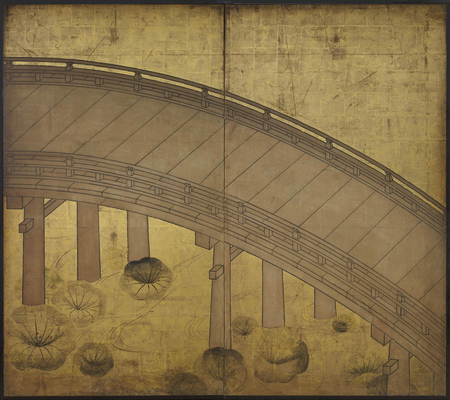Product Description
7711 A two-fold paper screen painted in ink and colour on a gold ground with the Uji River and lotus beneath its renowned bridge
Rimpa School, Japan 17th century Edo period
Dimensions: H. 167cm x W. 188.5cm (66” x 74¼”)
The depiction of the famous bridge at Uji is from a genre of Yamato-e (Japanese painting) known as meisho-e (paintings of famous places). Uji was favoured by members of the Imperial Court who used the area as a retreat; historic documents show a screen painting of Uji Bridge in autumn, which was displayed in the Imperial Palace in the ninth century.
Japanese poets have long praised the scenic beauty of the Uji River which flows from Lake Biwa to Osaka Bay. Literary references to the location abound in Imperial poetry and pre-date any existing images. The Man’yoshu (Collection of Ten Thousand Leaves, eighth century) and the Kokin-shu (Collection of Poems from Ancient and Modern Times, early tenth century) include references to such features as the arching bridge (first constructed in 646 A.D.), while hinting at the religious associations of this area.
In the 11th century, Uji became home to the Pure Land (Jōdo) Buddhist temple Byodoin and its famous Hōōdō (Phoenix Hall). The temple and its grounds are a replica of Amida Buddha’s Western Paradise, a three-dimensional construction based on the Kanmuryōjukyō (Contemplation Sutra). Such literal manifestations of imaginary locations helped the aristocracy envision Paradise, a place they clearly hoped to return to after death.
In Buddhism, it is said that the lotus flower blossoms in the Paradise and it is one of the most important symbols of enlightenment. The lotus also represents a pure soul in the physical world as it creates beautiful flowers from muddy waters.
In the light of religious connotations, the bridge is often considered to represent the connection between this life and the Pure Land.
A well-known painting depicting water fowl in a lotus pond by Tawaraya Sotatsu (d. c. 1640), the founder of the Rimpa School, is housed in the Kyoto National Museum (National Treasure). Another example of the same subject by Tawaraya Sotasu is housed in the Hatakeyama Memorial Museum of Fine Art in Tokyo. See Minamoto Toyomune et. al., Nihon bijutsu kaiga zenshu (Complete edition of Japanese painting art) Vol. 14 Tawaraya Sotatsu, (Tokyo, 1976), no. 20 and 56.
For examples of paintings depicting lotus by another Rimpa School artist Kitagawa Sosetsu (act. late 17th – early 18th century), see Murashige Yasushi ed., Rimpa Painting Vol. I, Seasonal Flowering Plants and Birds, (Kyoto, 1989), no.103 and 105.








